Small overlap front
The small overlap front evaluation consists of a driver-side and a passenger-side component. If the results of the two evaluations differ, then the combined small overlap rating is equal to the lower rating.
Driver-side
- Rating applies to 2019-25 models
Tested vehicle: 2019 Volkswagen Jetta 1.4T SEL Premium 4-door
The Volkswagen Jetta was redesigned for the 2019 model year. Driver-side small overlap frontal ratings are assigned by the Institute based on a test conducted by Volkswagen.
| Evaluation criteria | Rating |
|---|---|
| Overall driver-side evaluation | |
| Structure and safety cage | |
| Driver injury measures | |
| Head/neck | |
| Chest | |
| Hip/thigh | |
| Lower leg/foot | |
| Driver restraints and dummy kinematics | |
Passenger-side
- Rating applies to 2019-25 models
Tested vehicle: 2019 Volkswagen Jetta 1.4T SEL Premium 4-door
The Volkswagen Jetta was redesigned for the 2019 model year. Passenger-side small overlap frontal ratings are assigned by the Institute based on a test conducted by Volkswagen.
| Evaluation criteria | Rating |
|---|---|
| Overall passenger-side evaluation | |
| Structure and safety cage | |
| Passenger injury measures | |
| Head/neck | |
| Chest | |
| Hip/thigh | |
| Lower leg/foot | |
| Passenger restraints and dummy kinematics | |
| Driver injury measures | |
| Head/neck | |
| Chest | |
| Hip/thigh | |
| Lower leg/foot | |
| Driver restraints and dummy kinematics | |
Moderate overlap front: original test
Rating applies to 2019-25 models
Tested vehicle: 2019 Volkswagen Jetta 1.4T S 4-door
The Volkswagen Jetta was redesigned for the 2019 model year. Two moderate overlap frontal tests of the Jetta were conducted, one by the Institute and the other by Volkswagen. Ratings are based on both tests.
| Evaluation criteria | Rating |
|---|---|
| Overall evaluation | |
| Structure and safety cage | |
| Driver injury measures | |
| Head/neck | |
| Chest | |
| Leg/foot, left | |
| Leg/foot, right | |
| Driver restraints and dummy kinematics | |
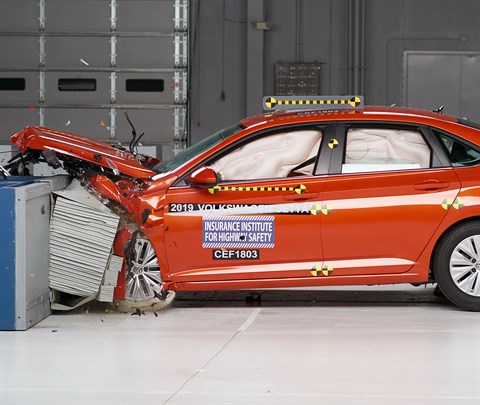
Action shot taken during the Institute's moderate overlap frontal crash test.
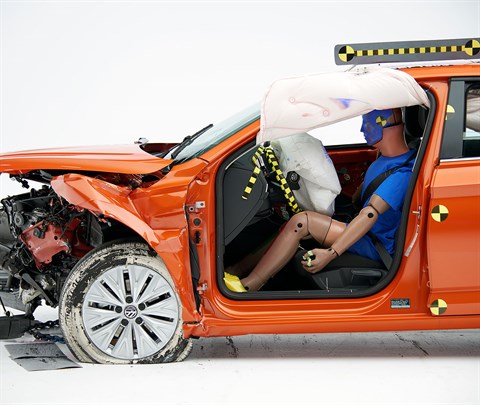
The dummy's position in relation to the steering wheel and instrument panel after the crash test indicates that the driver's survival space was maintained well (Institute test car shown).
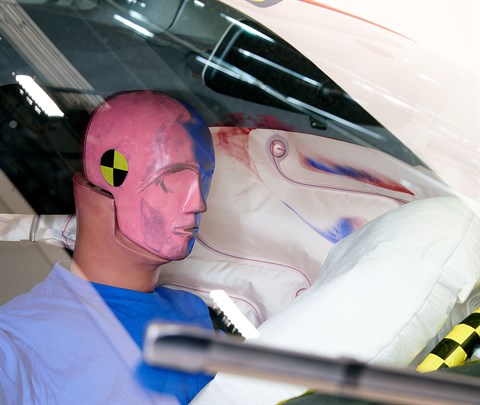
Smeared greasepaint indicates where the dummy's head contacted the side curtain airbag, mainly during rebound, in the Institute's test.
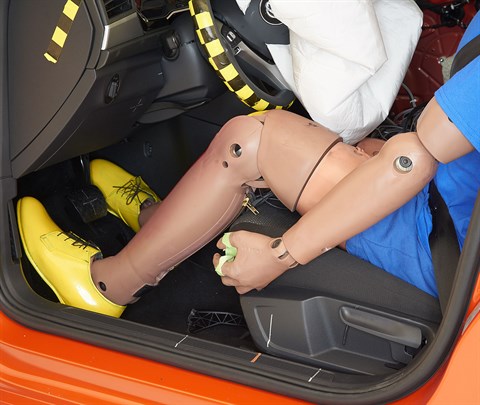
Intrusion into the driver's space was minimal in both tests, and all leg and foot injury measures were low.
Side: original test
Rating applies to 2019-25 models
Tested vehicle: 2019 Volkswagen Jetta 1.4T SEL Premium 4-door
The Volkswagen Jetta was redesigned for the 2019 model year. Side ratings are assigned by the Institute based on a test conducted by Volkswagen.
| Evaluation criteria | Rating |
|---|---|
| Overall evaluation | |
| Structure and safety cage | |
| Driver injury measures | |
| Head/neck | |
| Torso | |
| Pelvis/leg | |
| Driver head protection | |
| Rear passenger injury measures | |
| Head/neck | |
| Torso | |
| Pelvis/leg | |
| Rear passenger head protection | |
Side: updated test
Rating applies to 2019-25 models
Tested vehicle: 2021 Volkswagen Jetta 1.4T S 4-door
The Volkswagen Jetta was redesigned for the 2019 model year.
| Evaluation criteria | Rating |
|---|---|
| Overall evaluation | |
| Structure and safety cage | |
| Driver injury measures | |
| Head/neck | |
| Torso | |
| Pelvis | |
| Driver head protection | |
| Rear passenger injury measures | |
| Head/neck | |
| Torso | |
| Pelvis | |
| Rear passenger head protection | |

View of the vehicle just after the crash test.
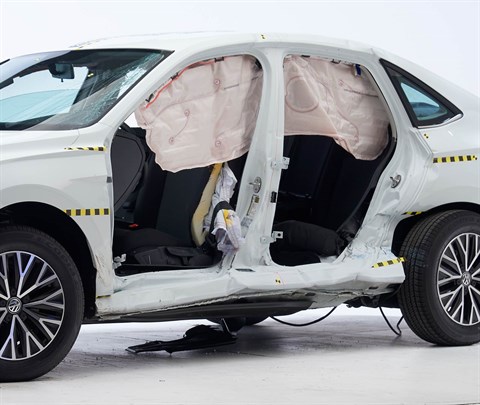
View of the vehicle after the crash with doors removed, showing the side airbags and damage to the occupant compartment.
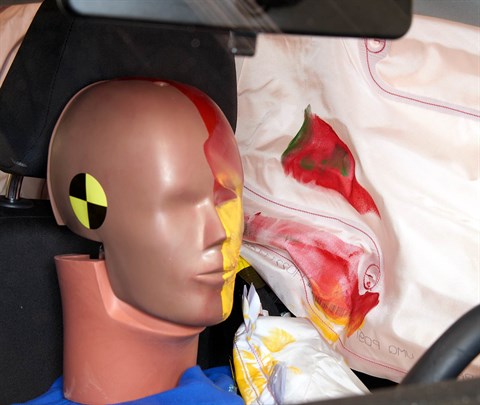
Smeared greasepaint shows where the driver dummy's head was protected from being hit by hard structures by the side airbags.
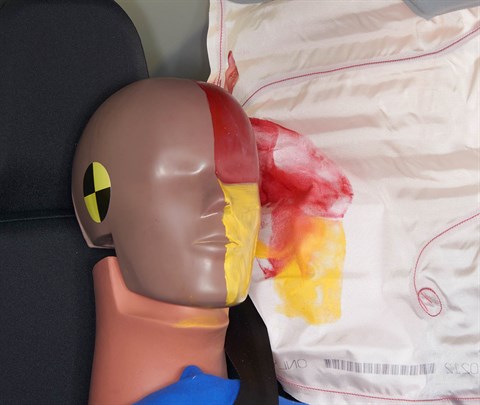
Smeared greasepaint shows where the rear passenger dummy’s head was protected by the side airbag.
Front crash prevention: pedestrian
Seat belt reminders
Rating applies to 2021-25 models
| Evaluation criteria | Rating |
|---|---|
| Overall evaluation | |
| Front row | |
| Unbelted occupant alert (audible & visual) | |
| Initiation time | |
| Duration | Negligible (under 8 seconds) |
| Volume | |
| Audio frequency | |
| Second row | |
| Startup status alert (visual) | None |
Child seat anchors
Rating applies to 2019-25 models
| Evaluation criteria | Rating |
|---|---|
| Overall evaluation | |
| Vehicle trim | S |
| Seat type | cloth |
This vehicle has 2 rear seating positions with complete child seat attachment (LATCH) hardware.
It has 1 additional seating position with a tether anchor only.
| Evaluation criteria | Rating |
|---|---|
| Overall evaluation | |
| Vehicle trim | S |
| Seat type | cloth |
| Rating icon | Rating |
|---|---|
| G | Good |
| A | Acceptable |
| M | Marginal |
| P | Poor |
| Seating positions that rely on borrowed lower anchors or have only a tether anchor available are not rated. | |
thether anchor symbol | Tether anchor |
lower anchor symbol | Lower anchors |
| Lower anchor(s) can be borrowed from adjacent positions(s) | |
| No hardware available |
Details by seating position
| Position | Rating |
|---|---|
| 1 | |
| Tether anchor | |
| easy-to-find location | |
| no other hardware could be confused for anchor | |
| Lower anchors | |
| not too deep in seat | |
| not too much force needed to attach | |
| difficult to maneuver around anchors | |
| 2 | |
| Tether anchor | |
| easy-to-find location | |
| no other hardware could be confused for anchor | |
| Lower anchors | |
| none available | |
| 3 | |
| Tether anchor | |
| easy-to-find location | |
| no other hardware could be confused for anchor | |
| Lower anchors | |
| not too deep in seat | |
| not too much force needed to attach | |
| difficult to maneuver around anchors |
